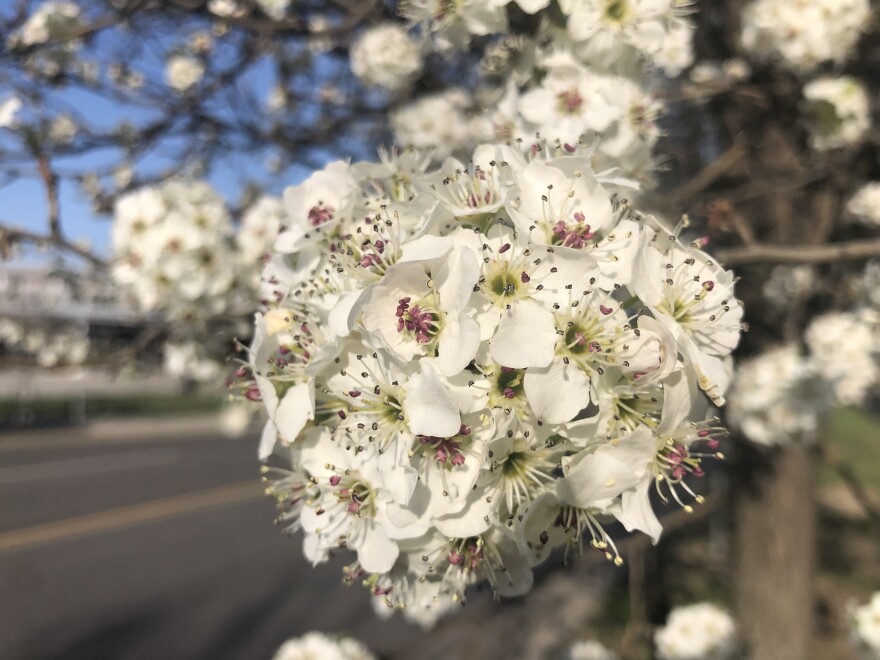
They’re called Bradford pears, Callery pears and about two dozen other names. Scientists say it’s time to remove these trees, because they’re wreaking havoc. Here’s one way to help in Kansas and Missouri.
It’s the perfect time of year to do birds and butterflies a solid — by killing an invasive, ornamental and all-too-common pear tree.
This April and May, if you live in or near Kansas City and Topeka and can destroy an ornamental pear on your property, you can get professional help picking out a free replacement tree guaranteed not to wreak environmental havoc.
The annual Deep Roots KC program will give out hundreds of free trees. This year, the program includes a giveaway site in Topeka for the first time. In coming years, the group plans to expand to other Kansas cities.
Early April is when highly invasive ornamental pear trees burst into showy displays of white (often funky-smelling) blooms that make them easy to spot as you drive through many towns, cities and even rural areas across Kansas and Missouri.
The pear trees go by a few dozen names — including Chanticleer, Bradford and Cleveland. They’re all variations of the Callery pear species, Pyrus calleryana.
Landscapers and homeowners planted loads of them over the decades (and still do) because the flowers are pretty and the trees are supposed to be sterile and well-behaved.
Instead, they’re so good at reproducing, they put rabbits to shame.
These aggressive spreaders choke grassy and treed landscapes alike. That squeezes out the native plants that wildlife relies on.
The effects ripple throughout the food web. Butterflies and moths, for example, need those native plants to lay their eggs and fill the pastures, prairies and woods with new generations of caterpillars. Fewer fat, juicy caterpillars each spring and summer translates into fewer baby birds.
To make matters worse, the pears aren’t alone. A number of other non-native invasive species, such as bush honeysuckles, spread just as aggressively in the Midwest and compound the problem.
Scientists have found 90% of the caterpillar population disappears from natural areas infested with these and similar invasive species. Johnson County Park and Recreation District workers have spent years removing hundreds of rogue pear trees from Shawnee Mission Park, and still aren’t finished.
Homeowners who would like a free native tree to replace an ornamental pear can sign up online. You’ll need to chop down a pear, show a photo to the organizers, and then show up to one of three events in Lee’s Summit, Lenexa and Topeka to pick out a replacement tree.
Experts from the Kansas Forest Service at the events can help you pick among an assortment of options ranging from serviceberry and redbud (which put on showy blooms much like ornamental pears do) to oaks that can feed hundreds of butterfly and moth species.
Identifying and removing ornamental pears
Some states have banned the sale of Callery pears, but the trees are still sold in Kansas and Missouri under a wide variety of names.
To check whether a tree on your property belongs to this invasive species, you can download apps such as iNaturalist (from National Geographic) and snap a photo.
Most trees that you spot in Kansas and Missouri covered in white flowers this time of year are invasive ornamental pears. They have clumps of five-petaled white blossoms that open up before the tree leafs out.
The Missouri Department of Conservation lists other species that look similar on its website, to help you avoid misidentifying an invasive pear.
To kill an ornamental pear, chop it down and then immediately treat the stump with herbicide – otherwise it will not die.
Celia Llopis-Jepsen covers the environment for the Kansas News Service. You can follow her on Twitter @celia_LJ or email her at celia (at) kcur (dot) org.
The Kansas News Service is a collaboration of KCUR, Kansas Public Radio, KMUW and High Plains Public Radio focused on health, the social determinants of health and their connection to public policy.
Kansas News Service stories and photos may be republished by news media at no cost with proper attribution and a link to ksnewsservice.org.
